
1994 was the year Justin Hall, a college undergraduate, created links.net the world’s first blog. Back then it was just a few links, a little text, and a couple of pictures.
Blogs have come a long way forward to today and there are now an estimated 600 million blogs worldwide. As well as this 80% of internet users regularly read blog posts, making them extremely popular.
In this blog, we will cover:
How do you write a top-ranking, keyword-rich blog post?
How do you structure a blog post?
How long should blog posts be for SEO?
How do you add keywords to your blog post?
Using social media to promote your blog content
The benefits of working with an agency to create content
What is a blog?
By definition “Blog” is a shortened form of a “weblog,” meaning a record of opinions, thoughts, and experiences published online for others to read.
From a business point of view, blogs are widely considered one of the most powerful online marketing tools – boosting your search engine ranking, building your brand, and growing a community of prospective customers.
It’s not as easy as posting an article with a few bullet points listing the features and benefits of your business. To harness the true marketing power of a blog, your articles need to be the perfect blend of information, relevance, entertainment, value and optimisation.
So how do you achieve this magical blend? Well, here are our tips on how to write top-ranking, optimised blog posts.

Why write a blog?
First, let’s discuss why you need to add content to a blog in the e first place. You’ve got your website and your social media channels. Do you really need to invest in another online marketing channel?
If you want to perform well organically online, then yes. Without a blog, you’re limiting the impact and reach of your website, social media, & all other online activities because…
1. Blogs drive traffic to your website via search engines
A blog is an important piece of your online marketing puzzle as it can drive traffic to your website through Search Engine Results Page (SERP). A carefully researched blog plan allows you to use your content to rank for a wider range of key phrases. Your website contains limited content. With a blog, you create more indexable pages, and if the pages are optimised correctly, you’ll have more opportunities to rank.
And with each new post, if written well, your reach will get wider. The wider your reach, the more clicks you are likely to get on your domain, which helps your search engine rankings too. Blogs can be a great way to target people that are maybe higher up the marketing funnel, ensuring it is your company, name, or service that keeps appearing throughout their customer journey. What’s more, sites that are frequently updated are boosted by search engines like Google too, and a well-maintained blog is an easy way to keep your website content fresh.
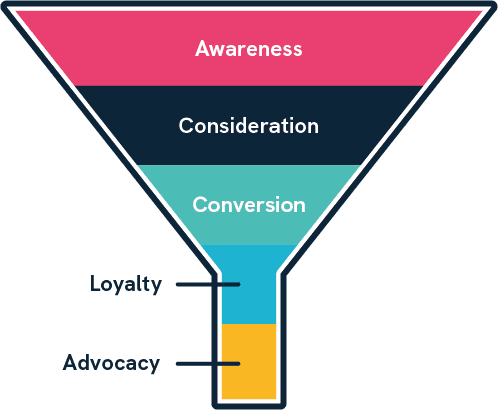
Source: Sprout
2. Blogs drive traffic to your website via social media
Aside from the SERP, blogs also give you content to share via social media to encourage click-throughs to your website, generate leads and build your brand. If your content is interesting and entertaining, people will share it, broadening your reach.
3. Blogs build your brand and market your business
Blogs are a great way to attract an audience and build a community. As people interact with your content on social media, it markets your brand to new potential customers and builds your reputation as an authority in your field. And as more people visit your website, mention your brand name, and share your content, Google will see you as an authority too, and boost your ranking accordingly.
Blogs also give you a platform to get your persona across. With limited pages on your website, it can be difficult to connect with your audience and demonstrate your brand values.
Through a blog you can build a relationship with people, tell your brand story, and show what is important to your company. As your audience gets to know you, you build trust, authority, and relevance. This can promote repeat purchases and gently move leads through the buying process – not to mention boost your search engine rankings.
4. Blogs can be used to build links
Link building is an important SEO strategy and blog articles are a great tool that you can harness to create links.
Guest blogging, commenting, creating blogs that serve as resources and putting together newsworthy content are effective outreach strategies that can build links to your site and boost your SEO.
These links should be relevant though and from authoritative sites. Creating quality blogs is one of the most natural ways to build links, and if done well, can be a strong passive link-building asset. Spammy link-building sites and paid promotional posts can negatively affect your SEO, so it’s important to build links legitimately.
What should you write about on your blog?
1. How to choose a blog topic
All successful blogs need a content plan that is based on sound key phrase research. In the research process, you’ll decide what key phrases users might be searching for and which ones you want your website to rank for. You would then look at who currently ranks for these phrases and try to create blog content that trumps the competition and therefore, tops the SERP rank.
For example, if you’re looking to push the sustainable features of your holidays, “sustainable sailing holidays” is a key phrase that might pop up in your research. You’d then want to assess the SERP and if it matches what you want to advertise, write a top-ranking, optimised post related to this phrase for your blog.
Depending on the SERP at this point it may be worth checking whether a blog is the right format. If the SERP is only including product pages, then a 2000+ word blog isn’t going to cut it. Similarly, if the first page is flooded with content-heavy, detailed information, writing 3 bullet points, and adding a stock image won’t touch the sides.
The key to a good, shareable blog is to make your articles useful. Add value to the reader by informing, educating, and entertaining, but don’t go for the hard sell. You need to get inside the head of your target consumer, and understand what questions they need to be answered or what information they may find useful or interesting. Anticipate what they might look for and what language they could use. You can also conduct research with freedom of information requests and/or surveys to uncover newsworthy content that will pique the interest of your target audience.
Source: Pixabay
2. Decide on your target user’s intent
When using search engines, a user can have a different motivation, desired outcome, or intent. There are 4 main types of user intent:
- Informational intent: I want to know
Lots of searches on the internet are made by people who are looking for information about a given topic e.g., the weather, indoor plants or SEO. In this case, people have a specific question relating to the topic or they simply want to know more about it.
- Navigational intent: I want to go
People with this intent are trying to locate a specific website e.g., people who search for “Solve Web Media, Pinterest, Gov.uk” know where they want to go, they just need to find the site.
- Investigational / Commercial intent: I want to choose
Some people have the intention to buy in the near future but use the web to do their research first. Users with this intent ask search engines queries like “which washing machine is the most eco-friendly?” or “top 10 laptops 2022” These people also have transactional intent, but they need more time and convincing before they’re ready to buy.
- Transactional intent: I want to buy
Users with this intent are ready to make a purchase, but they are using a search engine to locate the best deal e.g., “converse high tops size 7 womens”. As the content creator, you need to decide what your target user’s intent is and sculpt your content to meet this intent.
3. What type of content to post on your blog
People are attracted to things that benefit them, so teach your readers something, answer a question or give them useful information. They’re much more likely to share an article they find useful or helpful, whether they’re interested in your business or not.
Tips, ‘how-tos’, top 10s, question/answers articles are great ways to share your knowledge, and hopefully, others will share it too, which builds your brand, market your business, and boosts your SEO.
Here are some other types of content you can include on your blog:
- How-tos
- Table of contents
- Live feeds e.g., webcams or weather reports
- Resources: Calculators & tools
- Quizzes, which x is best for you
- Lists
- FAQs
- Reviews
- Case studies
- Video content
- Infographics
- Interviews
- Guest Posts
- Surveys & data
Whatever you choose to write about, research your topic thoroughly and cite your sources. No one is going to share a wishy-washy post with questionable figures. Your article needs legs, to impress your audience with your expertise, industry knowledge, and connections. Once you’ve decided what to write, it’s important to stick to your content plan. Blog regularly, ideally at least once a month, or you risk undoing your branding-building, SEO-boosting efforts.
4. Increase engagement and connect with your customers
If you’re a company/business, blogs can allow you to be relatable. Put yourself in your reader’s shoes and ask yourself what “problems” would they be looking for answers to? Once you do this you will appeal to your audience and increase engagement. Your content should be high quality but also educational, entertaining, and always relevant. Being authentic and open with your audience will also naturally increase trust too.
If you’re a business (especially a large one), blog posts can also be a great way to connect with your employees. Creating a sense of community within the company by sharing company updates, team days out, charity work, and more is always a good way to connect on a personal level. If you send out a company newsletter, then blog posts can allow you to elaborate on news updates by linking out to a longer article.
5. Do your Research
When looking for content, you should also look into current trends. Connecting relevant content with current trends is another great way of engaging your audience in your blog.
Whilst doing this, it is also important to check keyword trends. Google trends will show you the fluctuation in how much that keyword has been searched over a time period you choose. When looking for content to write, consider looking back at which of your old blogs are doing well. This will give you an idea of what your audience likes to read and will want to read in the future.
How do you write a top-ranking, keyword-rich blog post?
Now, you’ve got your plan, you’ve got your topic, but how do you write an optimised blog article?
Writing a top-ranking, optimised blog post is about finding a balance between writing for search engines and writing for users. In fact, you should write for the user first, but you also need to make sure users can find this content when they are Googling. That’s where SEO comes in to help.
In 2011, a new Google algorithm update was announced called, “Google Panda”. This update announced that websites with low-quality content would be marked down in comparison to well-written content. This was one of the main signals that Google was now focussing on user experience. The update encouraged high-quality content, quality over quantity, and the need to avoid duplicate content. Google’s E-A-T appeared in 2014, whereby it was encouraged to write content that showed expertise, authority, and trust.
How do you structure a blog post?
1. Develop a clickable title, without using clickbait
Your title is what will appear in the SERP so it’s essential that it grabs the attention of users. Your article will be one in a long list of many, so it’s important to make yours stand out. You need to introduce your article in the most intriguing way possible. “How” or “why” are good words to include as they address users’ questions.
In fact, your title can be a question itself, mirroring the query of your target user. If you’re writing a list of reasons why or a top 10, including the number in your title. And contrary to what you might think, odd numbers can be just as enticing as even ones.
Don’t be tempted to use clickbait though. Your title needs to accurately reflect the content of your article to avoid disappointing users and increasing your bounce rate.
When writing a title some great ways to make it more intriguing are:
- Adding numbers! It has been proven that numerical titles perform well. This is because you immediately hook the reader’s interest.
- Length matters when it comes to article titles. You do not want a title that is too long otherwise you may lose the attention of your readers. Creating a title that is short, snappy, and tells the reader exactly what they are getting. Titles are also perfect for driving social sharing and will impact click-through rates.
- Understand the reader’s problem to provide them with a solution and place this in the title.
- It has been proven that verbs move people to click over nouns and adjectives, so keep this in mind when writing out your next title.
Only use these tips where it is natural, you don’t need to try and use them all at once.
2. Start with a compelling introduction
If people are clicking on your article, then congratulations, you’ve done a great job with your title. When people get to your post, you need to continue the intrigue with a compelling introduction that encourages people to read on.
Your first sentence is the most important. Start with a hook, like a question or interesting fact or figure that will pique their interest. Then, set the tone of the article, introduce the topic, and give away clues to what you’re going to talk about. Include enough intrigue that people want to read on, without giving away too much.
3. Break paragraphs up into manageable chunks
You need to make sure your writing is structured well. Break it up into manageable paragraphs. We live in a fast-paced digital world and chunky text instantly puts people off – they simply don’t have the time. Also, bear in mind that most people will view your content on mobile. Paragraphs look much longer on small devices than on wide desktop screens.
4. Use subheadings
Subheadings are a great way to break up paragraphs and make them easier to digest. In a recent survey, 43% of people admitted to skimming blog posts, rather than reading in detail. Subheadings stand out and attract these types of readers, giving you extra opportunities to keep them engaged. What’s more, search engine bots crawl or scan in a similar way, so subheadings are ideal spots for keyphrases.
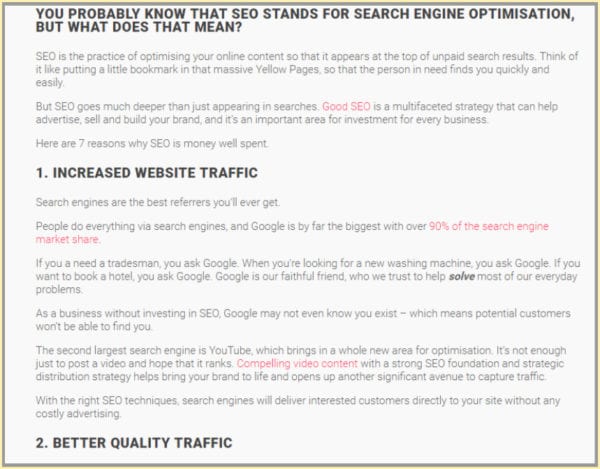
Source: Solve Web Media
5. Keep your language simple
With blog articles, the simpler the language the better. Shorter sentences are easier to read. And contrary to the grammar rules you might have learned at school, it can sometimes be better to start sentences with transition words like ‘and’ or ‘but’ to encourage people to continue reading – like I just did.
A general rule, avoid ‘flowery,’ complicated vocabulary. Use simple language that’s easy to understand for most people. Avoid jargon or be prepared to explain it.
Also avoid passive sentences – they are not easily processed (sounds robotic, doesn’t it?). People process active sentences (like this one) much easier, as they’re more natural.
Try writing as you talk first, and then go through and refine. Use active language, use slang if you want, and you can even choose a preposition to end with (you see what I did there?!). The purpose of a blog is to build relationships and demonstrate your brand personality. You want to entertain, not bore. We would recommend writing like you are talking to a friend as this is the easiest way to make your content more natural.
Note: Writing like you’re talking to a friend will depend on the industry and target audience, make sure you understand your target audience so you know who your blogs are being directed to.
Don’t be tempted to waffle though. No one has time for waffle.
6. But remember your spelling and grammar!
Writing as you talk doesn’t give you licence to completely forget about spelling and grammar. People need to understand what you’re talking about. Spelling mistakes can create entertainment for all the wrong reasons. It can also reflect badly on your company image, making the company seem unprofessional & disorganised as well as undermining your authority. Grammar can be the difference between knowing your s*%t, and knowing you’re s*%t!
7. Conclude and include a call-to-action
Don’t just stop your post abruptly. Conclude what you have been talking about and sum up the main points. And don’t forget to add the all-important call-to-action. You’ve successfully got the visitors to your site, and they’ve read right through your value-add post. You’ve put a lot of work in up to this point, so don’t lose them here. Now’s your chance to convert a simple browser to a fully-fledged lead. Ask readers to comment, contact you for further information, visit a page on your site to read on or subscribe to future posts. This is a critical part of your blog post, so don’t fall at the final hurdle.
How long should blog posts be for SEO?
It just depends on the SERP and the key phrase itself. There is no magic word count that will rocket your content to the top of the SERP.
A recent study showed that on average, the top 10 results for most Google searches are between 2,000 and 2,500 words. But different search queries and different users require different lengths of content to satisfy their needs. A short article may not answer a user’s question fully, but unnecessarily long content wastes time and shows you don’t understand the intent.
For example, for the key phrase: “what plugs do they use in St Lucia” the blog ranking in position 1 is under 500 words but it matches the intent.
Source: Google “what plugs do they use in St Lucia”
Ultimately you need to focus on the quality of your content, rather than the quantity. Make sure you answer the search query and address user intent as fully as possible – but without blabbering on. Structure your content well and use images, videos, and infographics where possible to keep users engaged.
Fun Fact: Did you know that your brain processes visuals 60,000 times faster than text and around 90% of the information transmitted to our brain is visual, meaning it’s easier for us to connect with images on a deeper level than text. Keep this in mind when creating content.
How do you add keywords to your blog post?
This is where you need the keyphrases that you defined initially. For your article to appear on the SERP for specific keyphrases, you need these in your content.
The key areas to add your keyphrases (or keywords) are:
- The article title
- Subheadings
- Naturally, peppered throughout the content itself
- The page title (the title that appears in the SERP)
- Meta description (the description that appears in the SERP)
- URL (the web address of your blog article)
It’s critical to use the keyphrases naturally though. Keyword stuffing is a major no-no and can get your site blacklisted by search engines like Google. Getting your keyphrase in the title and meta description can be especially tricky. For both of these, you need to summarise what your article is about, insert the necessary keyphrase and make it as clickable as possible, all in a natural way, and within specific character counts. It’s a bit like learning to pat your head and rub your stomach – it’s a skill.
But how many keywords should you use in a blog post?
Generally, have one main key phrase to focus on. Also make sure you include at least 3-4 other closely related phrases. For example, if you were writing about ‘Tacos’ it would make sense to include words like ‘Mexican food’ ‘Simple recipe’ ‘salsa’ or ‘guacamole.’ They are semantically connected to each other, therefore mentioning them signals to search engines that you understand the topic you are writing about
If you’re struggling to implement this naturally, you may be trying to force a key phrase into content that isn’t relevant.
Remember, pages don’t have to always rank no1 to be an asset for your website. If this page or blog is about a policy/feature that doesn’t have search volume, it doesn’t mean it’s unimportant. Stuffing keywords leads to poor engagement and disappointed users which sends bad signals to Google (which can make it more difficult for future content to rank well).
If you’ve got a WordPress site, there are built-in tools to assess the SEO and readability of your article when you’re finished. They highlight any areas that can be improved and give you a preview of what your article will look like on the SERP.
Using social media to promote your blog content
Once you’ve finished your article and optimised it, you need to promote it. And social media is the best platform to share your work. Facebook, Twitter, Instagram, LinkedIn, and TikTok are all great sites to post your articles to in a range of different formats. You need to accompany your links with appealing captions, posts, and images where appropriate, and don’t forget to include some relevant hashtags. Lead people in with an interesting point from your article, direct them to your blog and encourage them to share and/or comment.
Blog Case Studies
So, do our tips on how to write top-ranking, optimised blog posts really work? Let’s take a look at some examples…
If you manage to do all of this right, people will share your content, which creates natural links to your site – a major SEO benefit.
So, do our tips on how to write top-ranking, optimised blog posts really work? Let’s take a look at some examples…
Case Study 1 – PADSTOW SEALIFE SAFARIS
We wrote this top-ranking post for the lovely team at Padstow Sealife Safaris following our top blogging tips as outlined above, and it had some impressive results.
RANKINGS
The optimised post went live in 2019 and since then, just months later, the blog article alone ranks for 130 keyphrases in Google UK. The keyphrases that drive the most traffic to the site include “Padstow boat trips″ (ranking 1st in Google UK), “weever fish” (ranking 1st in Google UK), “weever fish sting” (ranking 2nd in Google UK), and “weaverfish” (ranking 2nd in Google UK). There are so many more, like we mentioned, 130! We just couldn’t list that many.
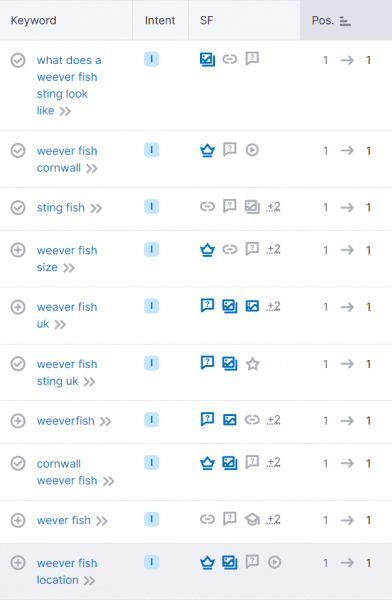
Source: Semrush
*At the time of writing this article, these stats were accurate. Google does fluctuate.
WEBSITE TRAFFIC
Since the blog post went live in 2019, 94,162 users visited the site by coming across the blog post using search engines. Not only that, the blog post has been read 88,796 times altogether and appears in position 1 for the keyword “weaver fish stings”.

Source: Google Analytics
Case Study 2 – SOLVE
We wrote a top-ranking blog post for our website following the blog tips mentioned above and we were ecstatic with the results!
RANKINGS
On the 3rd of June 2020, the Solve team wrote a blog entitled, “The Importance of Images in Marketing – Why a Picture is Worth 1000 Words” and it had some incredible results!The blog is ranking organically for 46 keywords including “importance images” (ranking 3rd in Google UK), “picture marketing” (ranking 6th in Google UK)and “marketing image”(ranking 12th in Google UK)
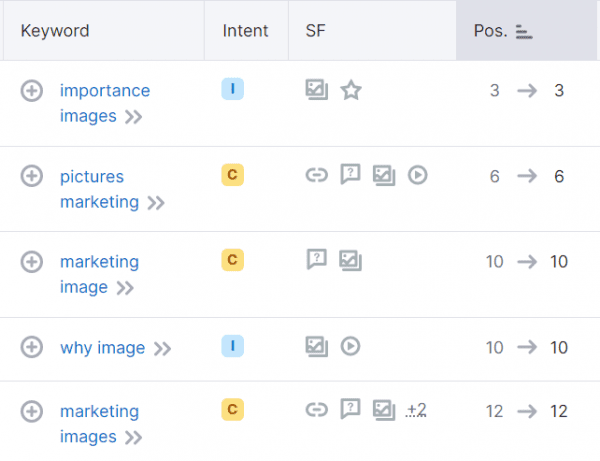
Source: Semrush
*At the time of writing this article, these stats were accurate. Google does fluctuate.
WEBSITE TRAFFIC
Since June 2020 Since the blog post has had 13,283 page views and not only that the post has been read 12,104 times in total!
Source: Google Analytics
The Benefits of Working With An Agency To Create Content
The benefits of working with an agency to create content include; the high-quality, professional work they produce, which will be written to positively impact your Google rankings.
An agency will create a content marketing strategy for you that will help your business grow in the long term as well as the short term. They will maintain reputation, and credibility whilst creating a stylish content template that your audience will enjoy and engage with.
No time to write blog posts?
Writing an effective blog article isn’t as easy as it seems and it can be time-consuming. But the marketing power of a well-written optimised blog is huge. Well-written, well-promoted, well-shared blogs build your brand, advertise your business and boost your SEO.
If you need extra help or simply don’t have the resources to manage a blog effectively in-house, our expert team of geeks and geekesses can do it all for you, from content planning and writing to promotion and optimisation.
To get noticed in the blogging world, give us a call today. Leave us a comment below if you have any ideas on how to boost your blog post.

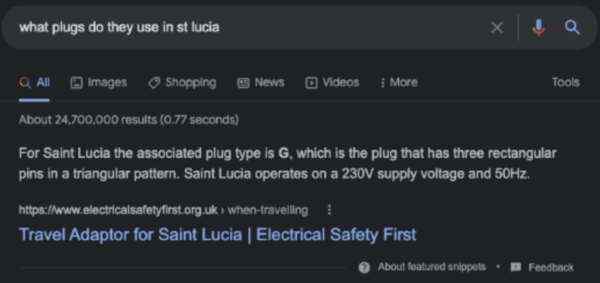


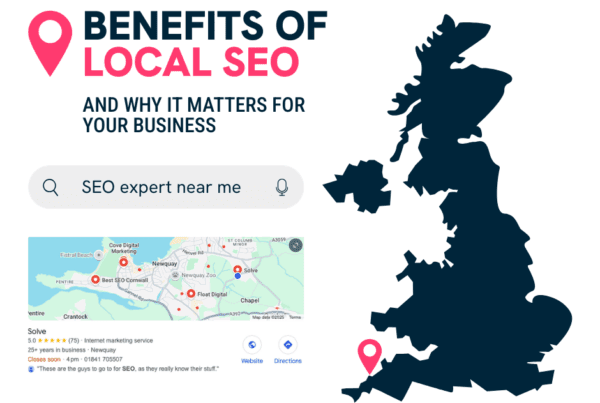




How search engines like Google work are the question of the decade for most Somebody out there must love because this platform called INK for All came across my desk, it seems to understand. As you type out an article in the tool, the AI dissects your content and then compares your work to similar content online, in real-time. INK for All also gives suggestions to help me be a better writer.
Hi Sofia, thanks for the comment. I can’t seem to find Ink for AI, can you help me find it? MAybe you need some SEO from Solve 😉
Wow, this is just an amazing guide to site optimization, I’m sure that thanks to your articles I will be able to promote my project in search engines much more effectively. It was also interesting to learn about the promotion in the search engine “Bing”. Do you think it’s worth promoting the project for this search engine? Regards, Andy
Thanks the article is really helpful…
Great blog post! Blogging is hard work, but it can also be very rewarding. It takes time to build up a blog and get traffic, but once you do, the money comes in. However, many bloggers give up before they start to earn money from their blogs. Thank you for sharing the blog post!